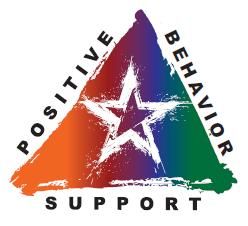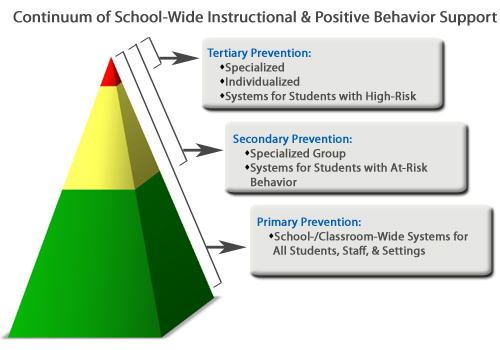Project Prevent and Address Bullying for Students with Disabilities
Preventing and Addressing Bullying via a Three-Tiered Model
Bullying in the Schools
Bullying in the schools is an important issue that schools districts deal with everyday. Bullying is defined as repeated and intentional verbal or physical abuse inflicted on an individual by a person who is in a position of power over another (Olweus, 1993). Bullying may look different in every school or setting, but its prevalence rates are alarming and its outcomes are even more startling. The many negative outcomes that have been associated with bullying are well established and include depression, anxiety, loneliness, low self-esteem, aggression, school maladjustment, negative peer relations, delinquency, lower academic efficacy and low academic achievement, to name a few (Crick, Casas, & Ku, 1999; Hawker & Boulton, 2000; Nansel et al., 2004; Schwartz et al., 1998; Eisenberg, Neumark-Sztainer, & Perry, 2003; Graham, Bellmore, & Mize, 2006; Lopez & DuBois, 2005; Thijs & Verkuyten, 2008). Students with disabilities experience bullying at higher rates than their peers, placing them at even greater risk of these negative outcomes (Blake et al., 2012; Rose et al., 2011; Swearer et al., 2012).
PBS: What is PBS?

School-wide positive behavioral supports are one way to address problem behaviors, such as bullying, in the schools. PBS schools are focused on providing their students with the resources and experiences to be successful in both their academic and social lives. Consistent with this goal, schools aim to improve both academic and behavioral outcomes by implementing effective and efficient academic and behavioral practices that are evidence based. PBS is a foundation for educational decision making the emphasizes the use of empirically based practices to improve behavioral outcomes for all students. PBS aims to reduce problem behaviors through the teaching and reinforcement of positive behavior.
PBS emphasizes the importance of data collection, and using that data to determine measurable outcomes to evaluate the progress or effectiveness of positive behavioral practices or interventions in the schools. It also holds that research has supported these practices to show that they lead to improved outcomes for students. Lastly, PBS is endorsed by the school as a whole and faculty and staff are committed to the integrity of the implementation of PBS.
PBIS follows a multi-tiered system of support framework by implementing a range of interventions based on the needs to the student population. PBIS follows the Response to Intervention (RTI), or Multi-Tiered System of Supports (MTSS) model by providing universal teaching of positive behaviors to the entire school as a Tier 1 intervention. This universal curriculum should be effective for 80% of the student population. For the 10-15% of students for whom this universal intervention is not effective, more intensive, targeted interventions will be implemented, referred to as Tier 2 intervention. Some students, roughly 5% in an MTSS framework, will still struggle with problem behaviors, and these students will receive individualized, intensive behavioral interventions at a Tier 3 level. Please refer below for several resources about RTI, MTSS, PBS, and Problem Solving:

NIU Resources
Social-Emotional Progress Monitoring
PBIS Resources
PBS and Bullying: What works?
One of the important aspects of behavior that PBS has historically focused on is Bullying within the schools. Research has suggested that while anti-bullying curriculums may somewhat reduce bullying in schools, a more effective and efficient way to attenuate these behaviors is to have staff members within the school who are knowledgeable and informed on bullying (Good, McIntoch, & Gietz, 2011).
In order to accomplish this goal and reduce bullying, individuals within the schools should devote a significant portion of their professional development to understanding bullying and building their knowledge base in this area. This webpage is designed to provide educators with the materials and resources necessary to accomplish this task.
NASP: A Framework for School-Wide Bullying Prevention and Safety
NASP: Bullying Prevention and Intervention: Position Statement